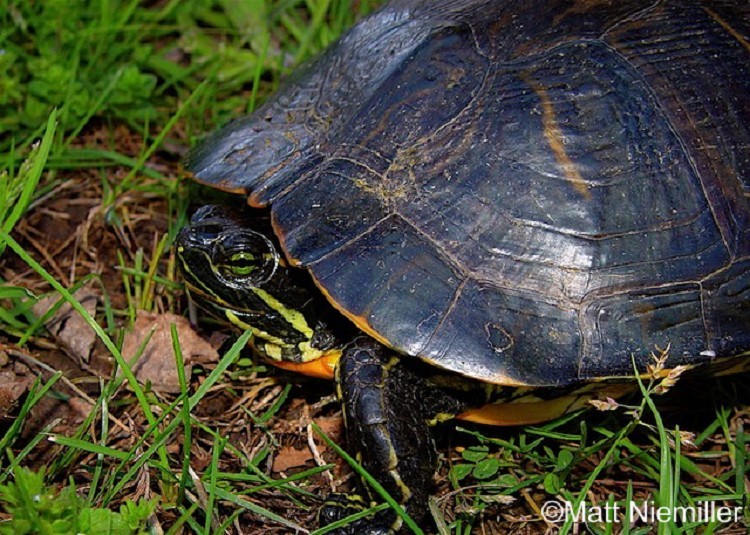Pond Slider, Trachemys scripta
Three subspecies are recognized in Tennessee: Red-eared Slider (T. s. elegans), Yellow-bellied Slider (T. s. scripta), and Cumberland Slider (T. s. troostii). Red-eared Slider occurs west of the Upper Cumberland and Tennessee River drainages to the Mississippi River, Yellow-bellied Slider occurs in the Tennessee River in the southeast corner of state, and Cumberland Slider occurs in the Upper Cumberland and Tennessee River drainages in eastern Tennessee.
Description: A medium-sized, aquatic turtle (adults average 5.0 to 8.0 inches in length, max 11.5+ inches but bigger ones have been reported) with a carapace (upper shell) ranging from dark green to brown to almost black with yellowish markings.
Head, neck, and limbs are striped yellow over a green or brownish skin. Lower jaw is rounded rather than flattened. Plastron (lower shell) is yellow with each plate usually having a dark spot.
Red-eared Slider usually has a distinctive, broad red stripe behind each eye. Yellow-bellied Slider has a large yellow blotch behind the eyes that joins the neck stripe. Cumberland Slider has a narrower yellow stripe behind each eye and fewer, wider stripes on legs, neck, and head.
Similar Species: False Map Turtle has a backward, yellow “L” mark behind eyes. Mississippi Map Turtle has yellow crescent behind eye. Northern Map Turtle has small spot behind eye. Painted Turtle has red coloration on shell. Ouachita Map Turtle has large rectangular patch behind eye and has a keel. Eastern River Cooter has dark, donut-shaped markings under the marginal plates.
Habitat: Prefers still waters such as ponds and lakes, but will also use slow-moving rivers, sloughs, and oxbow lakes. Aquatic vegetation, muddy bottoms, and abundant basking sites are important too.
Diet: Primarily vegetarians; but will eat insects, snails, tadpoles, crayfish, and fish.
Breeding information: Adults begin courting and mating in the water during spring, possibly continuing into fall. Females leave the water to find a suitable nesting site to lay 4-22 oval, white eggs. Eggs hatch in late summer or fall, but the young remain in the nest through the winter and dig out the next spring.
Status in Tennessee: Common across the state, especially Red-eared Sliders. Slider populations have declined recently due to collection for the pet trade and food trade.
Fun Facts:
- The name “slider” refers to the quick retreat into the water the turtles make when they feel threatened.
- Pond sliders, particularly the Red-eared Slider, are currently sold in pet stores world-wide and frequently are released into the wild outside of its natural range.
Best places to see in Tennessee: Basking on logs or fallen trees around the edges of lakes or ponds.
